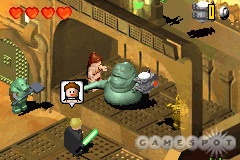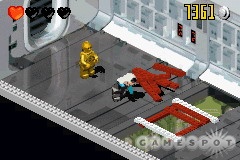Anyone with a Game Boy Advance that's remotely interested in the Star Wars franchise will probably get a kick out of Lego Star Wars II: The Original Trilogy. Watching the three original Star Wars stories play out with characters and scenery composed of Lego bricks is a whimsical treat. But even beyond the charming Lego theme, it's a solidly designed action adventure game. The GBA version may not be as flashy or have as many features as its console counterparts do, but it still contains a healthy amount of the play variety that its so-called big brothers have. There's plenty of shooting and lightsaber swinging to do, the isometric levels lend themselves to exploration, and there are dozens of playable characters to unlock. There are even a few levels devoted to piloting such fan-favorite vehicles as the X-wing and Millennium Falcon. As a result, Lego Star Wars II: The Original Trilogy has enough meat on its bones to please fans.

You've no doubt seen Star Wars-inspired Lego sets in the toy section of your local store. The whole idea behind Lego Star Wars II: The Original Trilogy is that those sets are used to depict the events that took place in Star Wars, The Empire Strikes Back, and Return of the Jedi. In this game, the scenery and vehicles of the Star Wars universe look like they were put together using Lego bricks, at least to the extent that the GBA's limited horsepower allows. The characters all have rounded heads and squat bodies, just like actual Lego people do, and little details like connector studs and classic Lego pieces are evident at every turn. They've also incorporated the Lego brand into gameplay. When you blast a stormtrooper or various decorative objects, they break apart into individual Lego bricks and leave behind Lego studs, the valuable in-game currency. When you encounter an object that needs to be assembled, holding the R button will cause the individual bricks to join together right before your eyes. In all, there are 16 levels to explore, which can be played as part of a story mode or in a free play mode that lets you jockey between as many as 36 different playable characters.
The gameplay itself is standard for this type of game, but the variety of activities to do, coupled with the Star Wars subject matter and Lego-inspired nuances, prevents the gameplay from ever becoming too tedious. Roughly two-thirds of the game's levels take place on foot, where you have to track down captive friends while battling stormtroopers at every turn. The combat in these levels is fast paced, to the point that you'll find yourself constantly tapping the attack button to disintegrate the numerous sluggish stormtroopers that seem to be placed every few steps or so. Running out of health isn't a major problem, since you only lose a few Lego studs when you lose a life. You're given a rank at the end of each level based upon how many studs you collect, however, and there's a significant reward waiting for you once you collect the Jedi rank on every level. That should provide a good incentive to some people to stay alive for as long as possible, while also letting casual players get through the game as painlessly as possible.
Meanwhile, the isometric environments are large and contain numerous secret rooms, some of which can only be visited by replaying the level with different characters in the free play mode. Although you can only control one character at a time, there are usually one or two other characters following you around that you can assume control of as the need arises. Different characters have unique abilities. Blaster characters, like Han Solo and Leia, can shoot enemies from a distance and assemble Lego bricks into useful objects. Jedi characters, such as Obi-Wan and Jedi Luke, must use their lightsaber weapons at close range, but they can jump higher than other characters and reflect the enemy's blaster shots back at them. They can also employ their force powers to shove enemies and to activate switches that non-Jedi can't. Some switches can only be activated by specific characters, such as R2-D2, C-3PO, and Lando Calrissian.
Compared to the previous Lego Star Wars game, vehicle-oriented levels are more plentiful this time around. Nearly a third of the game's levels put players into the cockpit of familiar vehicles to re-create key action scenes from the films. There's the Death Star trench run, featuring Luke's X-wing; the Hoth Battle, with Luke at the controls of a snowspeeder; the asteroid belt escape, between the Millennium Falcon and hordes of TIE fighters; the Endor chase, with Han at the seat of an Imperial Speederbike; and the climactic Death Star battle, once again featuring the Millennium Falcon. The environments for these aerial battles use the same isometric perspective as the foot-based missions, but the emphasis is less about exploration and more about blasting any enemy ships that come your way. Fans of The Empire Strikes Back, in particular, will enjoy the Hoth Battle level, since a major portion of it involves snagging Imperial Walkers with the Snowspeeder's tow-hook and tying up their legs until they topple to the ground.
The game puts the GBA's limited audio-visual capabilities to good use. The isometric backgrounds are crisp, detailed, and vibrant. Character sprites are a good size. They're big enough so that you can tell who you're controlling, but not so big that they hog the screen. Fans will easily recognize the characters and environments, even though the characters resemble squat Lego people, and the scenery is decorated with Lego pieces and studs. Levels based on locations from the film, such as Tatooine, the Death Star, Hoth, and Endor, are unmistakable. There isn't much animation in the environments, aside from some flicking computer panels and steam jets, but the silky-smooth movement of the characters more than makes up for the lack of background vitality. Story scenes, which were depicted in the previous game as still close-ups, are depicted in this game by the in-game character sprites. The dialogue is represented by goofy caption boxes, and the characters pantomime their reactions with exaggerated arm and body movements. It's hilarious to watch. For the audio, the developer simply lifted the music and sound effects right from the movies. The familiar John Williams score sounds great coming out of the GBA's speakers, and all of the various blaster shots and droid chirps sound crystal clear.

The only downside to the GBA version of Lego Star Wars II is that it isn't as thick with features as the console and PC versions of the game are. People that simply want to see the end of the story mode can do so in as little as two hours. Of course, the dozens of characters and secrets waiting to be discovered in the free play mode should provide sufficient incentive for most players to invest double or triple that amount of time to unlock everything the game has to offer. That's pretty much all there is to this specific version of the game, since the multiplayer modes and character editor from the other versions didn't make it into the GBA edition.
Those that crave a portable Star Wars fix should be satisfied with the GBA version of LEGO Star Wars II: The Original Trilogy. It may not be as slick or as meaty as its console counterparts, but it still manages to bring off the juxtaposition of Star Wars and LEGO with nearly the same level of irreverent charm, and it's a solid action adventure game besides.